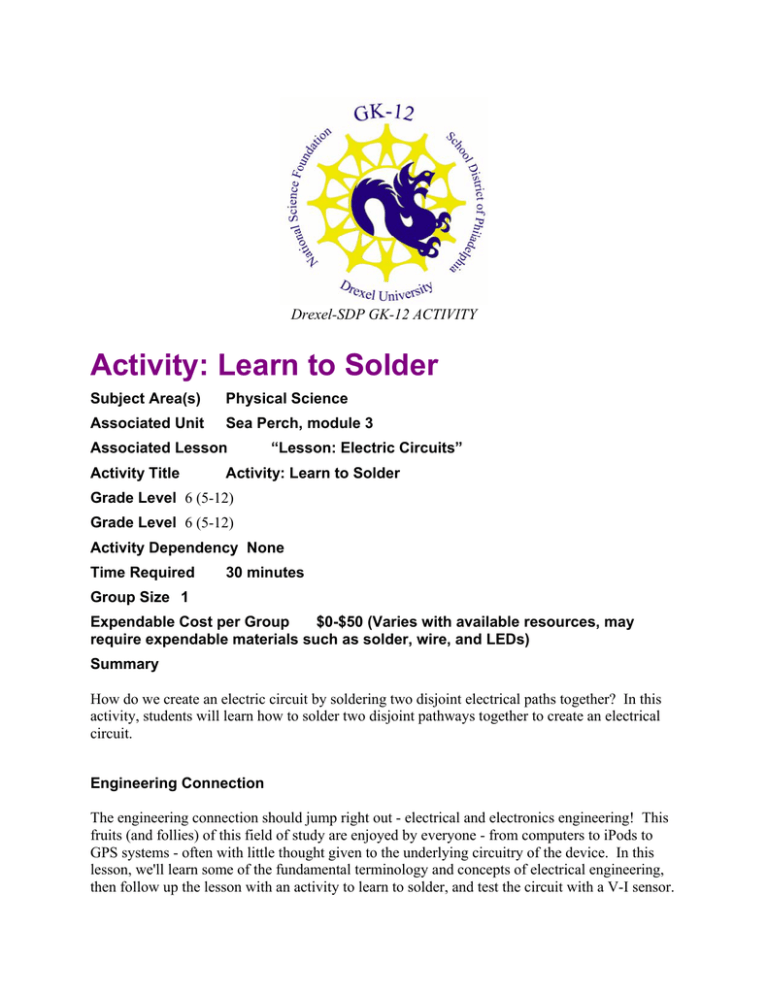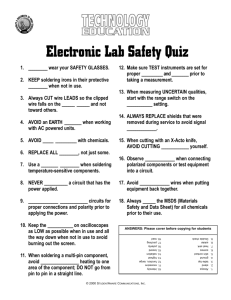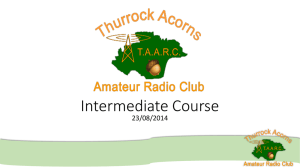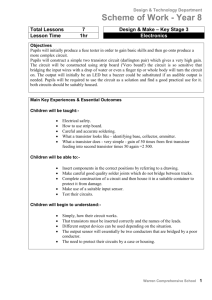Activity: Learn to Solder
advertisement

Drexel-SDP GK-12 ACTIVITY Activity: Learn to Solder Subject Area(s) Physical Science Associated Unit Sea Perch, module 3 Associated Lesson Activity Title “Lesson: Electric Circuits” Activity: Learn to Solder Grade Level 6 (5-12) Grade Level 6 (5-12) Activity Dependency None Time Required 30 minutes Group Size 1 Expendable Cost per Group $0-$50 (Varies with available resources, may require expendable materials such as solder, wire, and LEDs) Summary How do we create an electric circuit by soldering two disjoint electrical paths together? In this activity, students will learn how to solder two disjoint pathways together to create an electrical circuit. Engineering Connection The engineering connection should jump right out - electrical and electronics engineering! This fruits (and follies) of this field of study are enjoyed by everyone - from computers to iPods to GPS systems - often with little thought given to the underlying circuitry of the device. In this lesson, we'll learn some of the fundamental terminology and concepts of electrical engineering, then follow up the lesson with an activity to learn to solder, and test the circuit with a V-I sensor. Keywords Circuits, current, electric circuits, electrical engineering, electronics, solder, voltage Educational Standards (PA) • Science: Physical Science, Chemistry and Physics - Energy 3.4.B, Technology Education Physical Technologies 3.6.C. • Math: Computation and Estimation 2.2 Pre-Requisite Knowledge Some knowledge of electrical circuit terminology Learning Objectives After this lesson, students should be able to: • Solder a simple connection • Use the vocabulary of soldering Materials List Each group needs: Soldering iron (can be time-shared among students) Solder 6 wire pieces – about 2 inches long each. wire stripper breadboard 5v battery One LED Introduction / Motivation Ever wonder how electricity travels through your favorite electronic devices? Engineers love to play, too! By understanding how an electric circuit works, and applying the physical skill of soldering, an engineer can design his or her ideal gaming environment. This activity is intended to help you build your own electric circuit. It is not necessary for you to design the circuit from scratch; we will help you with that. Also, you will learn how to read and interpret and electrical circuit diagram. Vocabulary / Definitions Word Electricity Electric current Electric power Electric potential Solder (v.) Definition Energy that is transmitted in the form of rays A flow of electrons The amount of work done by an electric current Measurement of the distance from the equator Fasten together pieces of metal 2 Solder (n.) Resistor Voltage source The metal compound used to fasten together two pieces of metal A device used to oppose the flow of electric current. Device that supplies electric potential Procedure Background This lesson is intended to help students understand electrical energy. It is not necessary to memorize all the terminology, but the students should be aware of some different examples of electrical energy. Also, the students should be exposed to an electrical circuit diagram and be able to identify the voltage source and resistors on the diagram. Before the Activity This activity will be conducted after some discussion what is electricity, the symbols and relationships by which we describe electrical phenomena, the fundamental Kirchhoff laws of electrical phenomena, and designing electrical circuits. With the Students (After soldering and assembly, the student should end up with one LED with each lead soldered to a separate piece of wire; an LED assembly inserted into a breadboard; a breadboard that is supplied power by a 5v battery, wired to the positive and negative terminals. The positive and negative terminals of the breadboard are then jumpered to the columns that contain the leads of the LED.) Step 1: Put on safety goggles. Step 2: Examine the LED on the breadboard containing two disjoint, open electrical circuits. Does the LED light up when the battery is connected? Step 3: Strip about 1/2" insulation off both ends of two short wires. Step 4: Following the technique shown by the instructors, tin the contacts (the exposed wire) of one end on each of the wires using the pre-heated soldering iron and a bit of flux solder. Step 5: Following the technique shown by the instructors, solder the tinned ends of the wire together using the pre-heated soldering iron and a little bit more solder. Step 6: After the soldered wires have cooled, insert the non-soldered ends of the joined wire into the breadboard as shown by the instructors. Step 7: Connect the 5v battery to the positive and negative terminals of the breadboard as shown by the instructors. Does the LED light up? 3 Step 8: Try to make a connection to a lamp. Ask the students if they think they can understand how a lamp lights up – can they draw a picture of the circuit diagram to support their explanation? Safety Issues • Make sure students wear safety goggles • Be sure the students do not hover over soldering to avoid breathing fumes • Provide ample space between students soldering • Be aware of the location of cords, soldering irons and flammable materials Troubleshooting Tips If the LED does not light up, try reversing the leads (wires). If the electrical connection is not made between materials, use a V-I meter to identify the open part of the circuit. If the solder is not melting, give the iron more time to heat or dial up the wattage of the iron (if available). If you cannot solder to a surface, be sure all protective coatings have been removed or sanded. Investigating Questions Question 1: Why did the LED not light up before you had inserted the soldered wire? Can you draw a picture of the electrical design? Question 2: Why did the LED light up before you had inserted a correctly-soldered wire? Can you draw a picture of the electrical design? Question 3: What would happen to the LED if we used an AA battery for the power supply? A wall outlet? (hint: don't try it) Assessment Pre-Activity Assessment None Activity Embedded Assessment Supervise the students to ensure proper safety procedures – did they follow safety instructions? Post-Activity Assessment Does the student’s circuit work properly? Did they follow all the instructions – particularly with respect to safety? Students will be evaluated on a scale from 0 to 4 on: ______________ _____________ _____________ Safety Following Instructions Task Completion Activity Extensions 4 Construct the SeaPerch underwater remote controlled vessel – see http://www.coe.drexel.edu/seaperch/ Owner Drexel University GK-12 Program Contributors Dara Kusic Copyright Copyright 2007 Drexel University GK12 Program. Reproduction permission is granted for nonprofit educational use Version: Mar 2007 5






